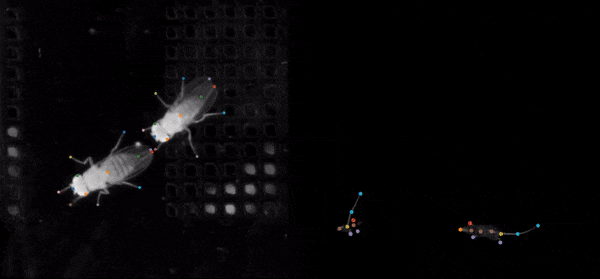SLEAP is an open source deep-learning based framework for estimating positions of animal body parts. It supports multi-animal pose estimation and tracking, and includes an advanced labeling/training GUI for active learning and proofreading.
SLEAP is developed in the Princeton Neuroscience Institute. It is written in Python and uses TensorFlow 2 for machine learning and Qt/PySide2 for graphical user interface.
- Purpose-built GUI and human-in-the-loop workflow for rapidly labeling large datasets
- Multi-animal pose estimation with top-down and bottom-up training strategies
- State-of-the-art pretrained and customizable Neural Network architectures that deliver accurate predictions with very few labels
- Fast training: 15 to 60 mins on a single GPU for a typical dataset
- Fast inference: 400+ FPS for batch, 10ms latency for realtime
- Support for remote training/inference workflow (for using without GPUs)
- Flexible developer API for building integrated apps and customization
If you use SLEAP in your research, please cite:
Talmo D. Pereira, Nathaniel Tabris, Junyu Li, Shruthi Ravindranath, Eleni S. Papadoyannis, Z. Yan Wang, David M. Turner, et al. 2020. "SLEAP: Multi-Animal Pose Tracking." bioRxiv. https://doi.org/10.1101/2020.08.31.276246.
SLEAP is released under a Clear BSD License and is intended for research/academic use only. For commercial use, please contact: Laurie Tzodikov (Assistant Director, Office of Technology Licensing), Princeton University, 609-258-7256.
Follow @MurthyLab on Twitter for news and updates!
Technical issue with the software? Open an issue on GitHub.
Press inquiries? Interested in using SLEAP in a commercial application? Reach out at sleap@princeton.edu.
- Talmo Pereira, Princeton Neuroscience Institute, Princeton University
- Arie Matsliah, Princeton Neuroscience Institute, Princeton University
- Nat Tabris, Princeton Neuroscience Institute, Princeton University
- David Turner, Research Computing and Princeton Neuroscience Institute, Princeton University
- Joshua Shaevitz, Physics and Lewis-Sigler Institute, Princeton University
- Mala Murthy, Princeton Neuroscience Institute, Princeton University
SLEAP is developed in the Murthy and Shaevitz labs at Princeton University. Funding: NIH BRAIN Initative R01 NS104899 and Princeton Innovation Accelerator Fund. SLEAP is the successor to LEAP (Pereira et al., 2019). To learn more about SLEAP and multi-animal pose tracking download our preprint on bioRxiv or watch the tutorial on SLEAP.




